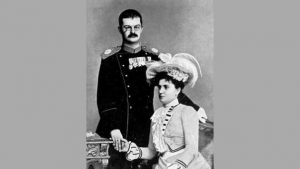 Technology
Technology  Technology
Technology  Humans
Humans 10 Everyday Human Behaviors That Are Actually Survival Instincts
 Animals
Animals 10 Animals That Humiliated and Harmed Historical Leaders
 History
History 10 Most Influential Protests in Modern History
 Creepy
Creepy 10 More Representations of Death from Myth, Legend, and Folktale
 Technology
Technology 10 Scientific Breakthroughs of 2025 That’ll Change Everything
 Our World
Our World 10 Ways Icelandic Culture Makes Other Countries Look Boring
 Misconceptions
Misconceptions 10 Common Misconceptions About the Victorian Era
 Mysteries
Mysteries 10 Strange Unexplained Mysteries of 2025
 Miscellaneous
Miscellaneous 10 of History’s Most Bell-Ringing Finishing Moves
 Technology
Technology Top 10 Everyday Tech Buzzwords That Hide a Darker Past
 Humans
Humans 10 Everyday Human Behaviors That Are Actually Survival Instincts
 Animals
Animals 10 Animals That Humiliated and Harmed Historical Leaders
Who's Behind Listverse?

Jamie Frater
Head Editor
Jamie founded Listverse due to an insatiable desire to share fascinating, obscure, and bizarre facts. He has been a guest speaker on numerous national radio and television stations and is a five time published author.
More About Us History
History 10 Most Influential Protests in Modern History
 Creepy
Creepy 10 More Representations of Death from Myth, Legend, and Folktale
 Technology
Technology 10 Scientific Breakthroughs of 2025 That’ll Change Everything
 Our World
Our World 10 Ways Icelandic Culture Makes Other Countries Look Boring
 Misconceptions
Misconceptions 10 Common Misconceptions About the Victorian Era
 Mysteries
Mysteries 10 Strange Unexplained Mysteries of 2025
 Miscellaneous
Miscellaneous 10 of History’s Most Bell-Ringing Finishing Moves
10 Merciless Monarch Murders You May Not Know About
Throughout history, being a monarch has never just entailed enjoying the fruits of being at the very pinnacle of the social order. For kings and queens, there’s always been the danger of a jealous usurper lurking in the shadows and being prepared to take deadly action to grab power. So it’s little wonder that many monarchs end up as paranoid despots. As this list shows, in many cases, their paranoia is all too rational.
Related: 10 Royal Mysteries Solved by Science
10 Queen Min of Korea (1851–1895)
Empress Myeongseong, often known as Queen Min, married Gojong, the 26th king of the Korean Joseon line, in 1866. This unfortunate woman managed to get on the wrong side of the Japanese, who saw Korea as being within their sphere. Min apparently opposed Japanese influence over her country and appealed to the Russians for help to counter it.
But Min could hardly have guessed at the ferocity of the Japanese response to her overtures to Imperial Russia. Japanese diplomats in Korea cooked up a plot to kill the empress. Early in the morning of October 8, 1895, the Japanese broke into the Gyeongbokgung Palace in Seoul. Finding their way to Min’s chambers, they hacked her to death with a sword. In a letter only discovered in 2021, one of the diplomats, Kumaichi Horiguchi, wrote, “We were stunned as [the assassination] was unexpectedly easy.”[1]
9 Emperor Commodus (AD 161-192)
The Roman Emperor Commodus, who reigned from the age of 18 for 12 years beginning in AD 180, has not been treated kindly by historians. The Roman historian Aelius Lampridius wrote that Commodus “was base and dishonorable, and cruel and lewd, defiled of mouth, moreover, and debauched.” It’s said that he neglected his responsibilities, preferring the pleasures of the flesh. These were amply provided for by a harem that featured hundreds of concubines of both sexes.
Commodus also had a habit of arbitrarily condemning perceived enemies to death, including relatives. His reputation wasn’t helped by the fact that his father, Emperor Marcus Aurelius, had been highly popular. A plot by his sister to assassinate Commodus was foiled, and she was the one who ended up dead. But in AD 192, another attempt on his life saw his food poisoned. When that didn’t kill him immediately, a wrestler called Narcissus finished the job by throttling him.[2]
8 King Carlos I of Portugal (1863–1908)
When King Louis I of Portugal died in 1889, his son Carlos succeeded him. It wasn’t a great time to come to the throne since his country was plagued by a range of problems in foreign affairs and domestic economic and political woes. Things got so bad in Portugal that, in 1906, a discontented populace rose in revolt. Carlos decided the best way to deal with the rebels was harsh repression.
To achieve this, the king gave carte blanche to a staunch conservative, João Franco, to take dictatorial powers over Portugal as prime minister. But Franco failed to pacify an angry population, and another rebellion broke out in 1908. During this latest disorder, Charles and his son and heir Louis Philip decided, unwisely as it turned out, to tour Lisbon in an open carriage. Assassins shot father and son dead.[3]
7 James I of Scotland (1394–1437)
Born in 1394, James was crowned the king of Scotland in 1424 after some years of living as a captive in England. He’d filled in the time by joining the English in one of their favorite pursuits—fighting the French. Once on the Scottish throne, James set about pacifying some of his troublesome relatives. He accomplished this by chopping off the heads of his uncle and some of his cousins at Stirling Castle.
This hardly enamored him with other Scottish nobles, and things went from bad to worse when the English defeated James at Roxburgh Castle, near the Scottish border. Plotting against James now reached a fever pitch. In 1437, the king’s chamberlain, Sir Robert Stewart, let a gang of some 20 assassins into the royal residence in the city of Perth. The king tried to escape his killers by crawling down a latrine drain, but the conspirators caught and killed him. Afterward, James’s wife, Queen Joan, rallied support, and Graham and his gang were captured. They were hung, drawn, and quartered for their treacherous regicide.[4]
6 King Gustav III of Sweden (1746–1792)
Born in 1746 in Stockholm, Gustav came to the throne in 1771, and according to Britannica, he was “an intelligent and cultured advocate of the Enlightenment.” True as that may have been, he spent much of his reign battling with the Swedish parliament, the Riksdag, over how political power should be divided between monarch and civil government. He did introduce some reforms that were progressive at the time, including the abolition of torture in the criminal justice system.
Fatally, Gustav managed to alienate the Swedish aristocracy, and this would be his undoing. Some noblemen formed a conspiracy to settle their differences with the king once and for all by assassinating him. In 1792, one Johan Jakob Anckarström attended a masked ball at Stockholm’s opera house. The king was present, and Anckarström shot him once in the back. Gustav lived on for another couple of weeks but succumbed to septicemia, a blood infection. Anckarström was arrested and put to death.[5]
5 Tsar Paul I of Russia (1754–1801)
Tsar Paul I may not be a familiar name but his mother’s certainly is. She was Catherine the Great and had seized the throne of Russia from her husband Peter III by killing him in 1762 when Paul was just eight years old. Catherine seems to have had little affection for her son, who was mainly enthusiastic about conducting military parades. Paul became tsar when Catherine died in 1796 at the age of 67.
Paul was actually more despotic than his mother, forbidding all foreign travel for fear of his subjects being influenced by the French Revolution. This and other measures made him unpopular with Russian nobles. The History Today website tells us that “his capriciousness and outbursts of ungovernable rage gave his opponents grounds to question his sanity.”
So some leading military figures decided to act against the tsar. They infiltrated the royal palace in St. Petersburg, found Paul hiding in his bedchamber, and strangled him. Some believed that Paul’s son, who now became Tsar Alexander I, may have been involved in the conspiracy.[6]
4 King Faisal of Saudi Arabia (1906–1975)
Born in 1906 in the Saudi Arabian capital of Riyadh, Faisal became his country’s absolute ruler in 1964 after his brother, King Saud, was deposed by a group of leading clerics and government ministers. Faisal introduced a series of reforms in Saudi Arabia. He joined the coalition of Arab nations that Israel defeated in the 1967 Six-Day War.
Usually, monarchs tend to be killed due to a conspiracy organized by disgruntled subjects. But the motivation behind Faisal’s murder is murky, to say the least. It was a seemingly normal day at the king’s court on March 25, 1975. A delegation of Kuwaitis waited in an anteroom to see Faisal, and with them was the King’s nephew, 27-year-old Prince Faisal Ibu Musaed. The prince entered the king’s chamber, drew a pistol, and shot Faisal three times in the head. Reports said that the prince was “mentally unbalanced,” but even so, he was publically beheaded a couple of months after the murder.[7]
3 King Alexander of Yugoslavia (1876–1903)

It was in 1882 that Prince Milan Obrenovich declared himself king of Serbia, ending the rule of the waning Ottoman Empire. But in 1889, apparently exhausted by the rigors of monarchy, he abdicated and went into exile, handing the crown to his 12-year-old son Alexander. Alexander ruled under the guardianship of a regency council until he turned 16 in 1893, when he took power into his own hands.
Initially, Alexander was welcomed by his subjects, but he squandered this goodwill with constitutional changes that concentrated more power in his hands. Then, he made himself even more unpopular by marrying his mistress, Draga Lunjevica, a woman said to be of “dubious reputation.” More constitutional shenanigans followed and the plotting began. The upshot was that in 1903, a band of army officers broke into the royal place in Belgrade, killing Alexander and Draga in a hail of bullets before throwing their bodies from a window.[8]
2 King Umberto I of Italy (1844–1900)
Umberto became the king of Italy in 1878, but as his rule became increasingly repressive and the country faced dire economic problems, many of his subjects turned against him. This resentment turned to violence in 1898 when workers and peasants marched on the northern city of Milan. Umberto’s response was to order the military to put a stop to the unrest. In carrying out their orders, soldiers used live ammunition, and hundreds died.
When Gaetano Bresci, an Italian émigré in the U.S., heard about this, he was enraged. A committed anarchist, he decided that something had to be done. Taking funds from the anarchist newspaper he’d cofounded, he traveled back to his homeland. There, he stalked Umberto until he managed to get close to the king when he visited Monza, which was not far from Milan. Seizing the moment, Bresci shot Umberto three times, killing him. The anarchist was handed a sentence of hard labor for life. But soon after, he was found in his cell, a reported suicide.[9]
1 King Birendra of Nepal (1945–2001)
In 2001, all was not well between 29-year-old Crown Prince Dipendra of Nepal and his mother and father, Queen Aiswarya and King Birendra. The root of the family tension was Aiswarya’s attitude toward the woman Dipendra wanted to marry, Devyani Rana. The queen had spoken against the young woman and had even threatened Dipendra with disinheritance if he went against her wishes.
This opposition to his marital wishes seems to have tipped Dipendra completely over the edge. On June 1, 2001, Dipendra attended a family gathering, pulled out an automatic weapon, and sprayed bullets into his relatives. The resulting death toll of nine included his father, mother, brother, and sister, as well as various other relatives. Dipendra, who was reportedly intoxicated, finally shot himself, although he took 30 hours to die. Fortunately, one brother, Gyanendra, was out of the country at the time, and he succeeded to the Nepalese throne.[10]








